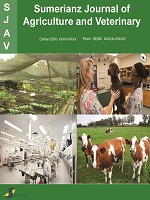Sumerianz Journal of Agriculture and Veterinary

Online ISSN: 2617-3077
Print ISSN: 2617-3131
Quarterly Published (4 Issues Per Year)
Journal Website: https://www.sumerianz.com/?ic=journal-home&journal=30Archive
Volume 3 Issue 7 (2020)
Enzyme Supplementation of Sorghum Diets Could Influence the Blood Profile and Histology of Digestive Organs in Broiler Chickens
Authors : Kennedy Oluwatosin Oluwamoroti Ohotuowo ; Izuki Esther Darlington ; Ozung Pascal Ogar
Abstract:This study evaluated the effect of dietary enzyme supplementation (phytase - PHY, xylanase-amylase-protease mixture - XAP and xylanase-beta-glucanase - XBG) on the blood profile and histology of digestive organs of broiler chickens. Three hundred and thirty, day-old Hyline broiler chicks were assigned to 11 treatments. Two basal diets were formulated; maize-soybean (positive control) and sorghum- soybean (negative control) with the sorghum diet further subdivided into 9 diets containing PHY, XAP and XBG at three levels (250, 500 and 750 mg/kg) each. At the 8th week, the blood profile and histology of the organs were determined. Results indicated significant (P < 0.05) effect of treatments on haematological and serum biochemical indices. Histopathological examination of the gizzard, duodenum and liver revealed mild to no distortions. The study concluded that for optimum blood profile and histological integrity of digestive organs, 250 and 500 mg of phytase® enzyme should be supplemented to sorghum diets.
Hypoglycemic Potential of Cocoa Powder in Monosodium Glutamate-Diet Induced Diabetic Mice
Authors : Jayeola Olayinka Christianah ; Okunlola Omolara ; Oyagbemi Ademola Adetokunbo ; JayeolaTolulope Grace
Abstract:Diabetes mellitus is a public health problem, one of the four priority non-communicable diseases (NCDs) targeted for actions by World leader. Historical documents from the 17th through mid-19th centuries contain numerous references to cocoa powder not primarily as a beverage, but as a prophylactic and therapeutic for a variety of ailments. Monosodium glutamate (MSG) enhances appetite and palatability of meals since it is been consumed as additives in most of our meal without caution, there is need to investigate if its overdose consumption can lead to diabetes which is a common ailment in our society nowadays. This study investigates the effect of cocoa powder on mice induced with diabetes using MSG the experiment was categorized into six groups ranging from mice fed with cocoa feed and those fed with MSG diet. The result showed significant increases in blood glucose level amongst those fed with MSG diets alone, thus suggested that MSG has the potential to induce elevation in blood glucose level thereby resulting to diabetes mellitus. Moreover, the result from this study showed that cocoa powder was able to cause reduction in blood glucose level in the MSG-induced diabetic mice. Therefore, it is no doubt that medicinal plants still play important role in the discovery of novel anti-diabetic compounds as in this case cocoa powder.
Feeding Value of Tiger Nut (Cyperus Esculentus) Meal for Growing Rabbits
Authors : Nsa Essien Ekpenyong ; Ozung Pascal Ogar ; Archibong Emmanuel Ekpo
Abstract:Aim/background: A feeding trial was conducted to investigate the feeding value of tiger nut meal for growing rabbits. Methods: Ninety six Chinchilla and New Zealand crossbred rabbits of mixed sexes were randomly allotted to six treatment groups in a Completely Randomised Design experiment; each group was replicated twice with eight rabbits per replicate. Six diets were formulated such that diets 1, 2, 3, 4, 5 and 6 contained 0, 8, 16, 24, 32 and 40% tiger nut meal respectively. The crude protein content of the diets was between 17.74 and 18.33% while ether extract was between 4.89 and 14.44%. Growth performance parameters and carcass characteristics were determined appropriately. Results: Feed intake, weight gain, feed conversion ratio, spleen and liver weight and nutrient retention showed significant differences (P 0.05) between dietary treatments. Feed intake, live weight and weight gain all increased with an increase dietary level of tiger nut meal up to 24% inclusion level beyond which depression occurred. The best feed conversion ratio was obtained for rabbits on the control and 16% dietary level of tiger nut meal. The highest protein retention was obtained for rabbits fed diets containing tiger nut from 0 – 16% level. The spleen and liver weight increased (P 0.05) with increasing level of tiger nut meal. Conclusion: The study concluded that 16% tiger nut meal can be included in diets meant for growing rabbit without compromising growth performance, nutrient digestibility and carcass characteristics.


